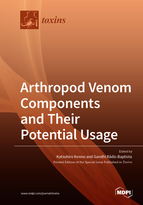Arthropod Venom Components and Their Potential Usage
A special issue of Toxins (ISSN 2072-6651). This special issue belongs to the section "Animal Venoms".
Deadline for manuscript submissions: closed (31 July 2019) | Viewed by 128884
Special Issue Editors
Interests: chemistry (isolation, structure and synthesis) of natural products; solitary wasp and ant venom peptides; sea anemone toxins; spider toxins
Special Issues, Collections and Topics in MDPI journals
Interests: transcriptome of arthropods, cnidarians and other venomous animals; peptide engineering; anti-proliferative peptides; membranolytic peptides; regulatory peptides; molecular biology; pharmaceutical biotechnology
Special Issues, Collections and Topics in MDPI journals
Special Issue Information
Dear Colleagues,
Thousands of arthropod species, ranging from arachnids (spiders and scorpions) to hymenopterans (ants, bees, and wasps) and myriapods (centipedes), are venomous and utilize their venoms for both defending themselves and predating preys. These venoms are invariably harmful to humans, and some may cause serious injuries, e.g., those from scorpions, spiders, and wasps. On the other hand, arthropods’ venoms have been known as rich sources of biologically active compounds and have attracted the attention of toxin researchers for years. Especially in this century, venom component analysis has progressed much more than ever because of the great advances of analytical techniques, in particular, mass spectrometry and next-generation deep (DNA and RNA) sequencing. As such, proteomic and peptidomic analyses utilizing LC–MS, as well as transcriptomics - alone or in combination with proteomics, have made it possible to fully analyze venoms’ components, revealing a variety of novel peptide and protein toxins sequences and scaffolds, potentially useful as pharmacological research tools and for the development of highly selective peptide ligands and therapeutic leads. Because of their specificity for numerous ion-channel subtypes, including voltage- and ligand-gated ion channels, arthropod neurotoxins have been investigated to dissect and treat neurodegenerative diseases and control epileptic syndromes. This Special Issue will collect information on such progress, encouraging contributions on the chemical and biological characterization of venom components, not only peptides and proteins but also small molecules, their mechanisms of action, and the development of venom-derived peptide leads.
Prof. Dr. Katsuhiro Konno
Prof. Dr. Gandhi Rádis-Baptista
Guest Editors
Manuscript Submission Information
Manuscripts should be submitted online at www.mdpi.com by registering and logging in to this website. Once you are registered, click here to go to the submission form. Manuscripts can be submitted until the deadline. All submissions that pass pre-check are peer-reviewed. Accepted papers will be published continuously in the journal (as soon as accepted) and will be listed together on the special issue website. Research articles, review articles as well as short communications are invited. For planned papers, a title and short abstract (about 100 words) can be sent to the Editorial Office for announcement on this website.
Submitted manuscripts should not have been published previously, nor be under consideration for publication elsewhere (except conference proceedings papers). All manuscripts are thoroughly refereed through a double-blind peer-review process. A guide for authors and other relevant information for submission of manuscripts is available on the Instructions for Authors page. Toxins is an international peer-reviewed open access monthly journal published by MDPI.
Please visit the Instructions for Authors page before submitting a manuscript. The Article Processing Charge (APC) for publication in this open access journal is 2700 CHF (Swiss Francs). Submitted papers should be well formatted and use good English. Authors may use MDPI's English editing service prior to publication or during author revisions.
Keywords
- venom components
- peptide toxins
- protein toxins
- proteomics
- peptidomics
- transcriptome
- venomics
- peptide ligand
- peptide engineering
- venom-derived peptide leads








